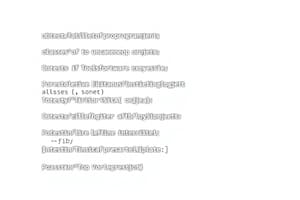Podcast
Questions and Answers
What is the primary purpose of a constructor in object-oriented programming?
What is the primary purpose of a constructor in object-oriented programming?
- To define the characteristics of a class.
- To specify the actions an object can perform.
- To create new objects from a class. (correct)
- To provide additional information about the source code.
Which term best describes a named set of instructions that perform a specific action in a class?
Which term best describes a named set of instructions that perform a specific action in a class?
- Parameter
- Object
- Attribute
- Method (correct)
What is the role of a 'parameter' when defining a method?
What is the role of a 'parameter' when defining a method?
- To define the type of value a method receives when it is called. (correct)
- To determine whether a block of code will execute.
- To define the name of the method.
- To specify the return data type of a method.
What does the term 'instantiate' mean in object-oriented programming?
What does the term 'instantiate' mean in object-oriented programming?
What is the significance of a 'void' return type when defining a method?
What is the significance of a 'void' return type when defining a method?
In object-oriented programming, what is a 'subclass'?
In object-oriented programming, what is a 'subclass'?
What is the purpose of a 'tester class' in a program?
What is the purpose of a 'tester class' in a program?
What is the role of a 'dot operator' in programming?
What is the role of a 'dot operator' in programming?
What does a 'commit' operation do in the context of programming?
What does a 'commit' operation do in the context of programming?
Which of the following best describes the concept of a 'programming style'?
Which of the following best describes the concept of a 'programming style'?
What is the primary purpose of a 'selection statement' in programming?
What is the primary purpose of a 'selection statement' in programming?
In software development, what is the 'DRY principle' aimed at?
In software development, what is the 'DRY principle' aimed at?
What is the concept of 'encapsulation' primarily focused on in object-oriented programming?
What is the concept of 'encapsulation' primarily focused on in object-oriented programming?
What is the primary function of an accessor method?
What is the primary function of an accessor method?
What does the process of 'decomposition' refer to in programming?
What does the process of 'decomposition' refer to in programming?
Which of the following best describes a parameterized constructor?
Which of the following best describes a parameterized constructor?
What is the primary function of an 'access modifier' in programming?
What is the primary function of an 'access modifier' in programming?
What is meant by the term 'scope' in the context of programming?
What is meant by the term 'scope' in the context of programming?
What is the main objective of 'refactoring' in software development?
What is the main objective of 'refactoring' in software development?
When is an operator considered a 'compound assignment operator'?
When is an operator considered a 'compound assignment operator'?
What is the main purpose of a mutator method?
What is the main purpose of a mutator method?
In the context of strings, what does 'concatenation' refer to?
In the context of strings, what does 'concatenation' refer to?
What is a 1D array?
What is a 1D array?
What is the role of an 'index' when referring to a data structure?
What is the role of an 'index' when referring to a data structure?
Which of the following best describes a 'loop control variable'?
Which of the following best describes a 'loop control variable'?
When does a postcondition need to be true?
When does a postcondition need to be true?
What does it mean to 'cast' a variable in programming?
What does it mean to 'cast' a variable in programming?
What is an 'alias' in the context of variables?
What is an 'alias' in the context of variables?
Which of the following best describes short-circuited evaluation in Boolean expressions?
Which of the following best describes short-circuited evaluation in Boolean expressions?
What distinguishes a 'static method' from an 'instance method'?
What distinguishes a 'static method' from an 'instance method'?
In a two-dimensional array, what does a 'row' represent?
In a two-dimensional array, what does a 'row' represent?
Which of the following is a good description of an 'off-by-one error'?
Which of the following is a good description of an 'off-by-one error'?
Flashcards
String literal
String literal
A sequence of characters enclosed in quotation marks. They are used to represent text in programs.
Syntax error
Syntax error
A mistake in the code that does not follow the programming language's rules.
Method
Method
A named set of instructions that perform a task.
Class
Class
Signup and view all the flashcards
Argument
Argument
Signup and view all the flashcards
Attribute
Attribute
Signup and view all the flashcards
Code review
Code review
Signup and view all the flashcards
Constructor
Constructor
Signup and view all the flashcards
Access Modifier
Access Modifier
Signup and view all the flashcards
Decomposition
Decomposition
Signup and view all the flashcards
Actual Parameter
Actual Parameter
Signup and view all the flashcards
Encapsulation
Encapsulation
Signup and view all the flashcards
Pseudocode
Pseudocode
Signup and view all the flashcards
DRY Principle
DRY Principle
Signup and view all the flashcards
Local variable
Local variable
Signup and view all the flashcards
Default Value
Default Value
Signup and view all the flashcards
Parameterized constructor
Parameterized constructor
Signup and view all the flashcards
State
State
Signup and view all the flashcards
Scope
Scope
Signup and view all the flashcards
Initialization
Initialization
Signup and view all the flashcards
Accessor method
Accessor method
Signup and view all the flashcards
Library
Library
Signup and view all the flashcards
Mutator method
Mutator method
Signup and view all the flashcards
Relational operators
Relational operators
Signup and view all the flashcards
Constant
Constant
Signup and view all the flashcards
Alias
Alias
Signup and view all the flashcards
Static method
Static method
Signup and view all the flashcards
Instance method
Instance method
Signup and view all the flashcards
Static variable
Static variable
Signup and view all the flashcards
Postcondition
Postcondition
Signup and view all the flashcards
Precondition
Precondition
Signup and view all the flashcards
Study Notes
Unit 1 - Object-Oriented Programming
- A software engineer designs, develops, and tests software.
- A class header includes the class keyword and the class name.
- Comments explain code but are ignored by the program.
- Source code is a set of programming commands.
- Syntax rules dictate how code is written.
- Syntax errors are mistakes in code.
- Attributes describe characteristics of an object.
- Behaviors are actions an object can perform.
- A class is a blueprint for creating objects.
- An object is an instance of a class.
- Object-oriented programming uses models of objects.
- A constructor creates a new object.
- The dot operator is used to call methods in a class.
- A method is a named set of instructions.
- Arguments are provided to methods.
- Parameters define expected input values.
- String literals are enclosed in quotes.
- An algorithm is a finite set of instructions.
- Conditions control code execution.
- Iteration statements repeat code blocks.
- Inheritance enables subclasses to inherit attributes and behaviors from superclasses.
- Subclasses extend superclasses.
- A tester class runs a program.
- Method signatures include the name and parameter list.
- The return statement exits a method.
- A void method doesn't return a value.
- Code review improves code quality.
- Commits save code changes.
- Documentation describes code purpose and functionality.
- Programming style guides code formatting.
- Selection statements execute code based on conditions.
- Data types define data formats.
- Variable declarations give variables names and types.
- Variables store values in memory.
- Decomposition breaks problems into smaller parts.
- Efficient code uses minimal resources.
- Pseudocode describes algorithms.
- Redundant code is unnecessary.
- Logical operators return Boolean values.
Unit 2 - Class Structure and Design
- The DRY principle minimizes code repetition.
- Access modifiers control visibility.
- Encapsulation hides internal data.
- Instance variables represent object attributes.
- Refactoring improves code structure without changing function.
- Constructors have a signature.
- Default values are predefined.
- No-argument constructors have no parameters.
- Call by value copies argument values.
- Local variables are defined within a block.
- Method overloading allows methods with same names but different signatures.
- Parameterized constructors accept arguments.
- An object's state is defined by its instance variables.
- Variable scope determines where a variable can be used.
- Assignment gives a value to a variable.
- Initialization gives initial values.
- Primative types are basic data types.
- Reference types hold object memory locations.
- Accessor methods retrieve object data.
- Libraries contain reusable components.
- Application Program Interfaces (APIs) are libraries.
- Return by value copies the value.
- Compound assignment operators perform operations and assign results.
- Compound expressions combine expressions.
- Concatenation joins strings.
- Expressions evaluate to a single value.
- Operands are data elements.
- Truncation shortens data.
- Boolean expressions evaluate to true or false.
- Mutator methods change object data.
- Relational operators compare values.
- Escape sequences provide special characters.
- Override redefines inherited methods.
Unit 3 - Arrays and Algorithms Vocabulary
- Data structures organize, process data.
- Elements are single values in a structure.
- A one-dimensional array stores single-line data.
- Indexes specify values' positions in a structure.
- Initializer lists create arrays by providing values.
- Traversing accesses elements sequentially.
- Decrementing decreases a value.
- Incrementing increases a value.
- Loop control variables determine loop end.
- Off-by-one errors occur when loops run one iteration too many or too few.
- Postconditions define the state after code execution.
- Preconditions define the state before execution.
- Instance methods require object creation.
- Static methods can be used without object creation.
- Static variables are shared by class instances.
- Constants have unchanging values.
- Casting converts types.
- Widening converts smaller types to larger types.
- Aliases create multiple names for the same object.
- Nested conditional statements are conditional statements within conditional statements.
- Compound Boolean expressions use logical operators.
- Short-circuited evaluations evaluate expressions until the result is clear.
- Truth tables determine boolean expression values.
- De Morgan's laws simplify Boolean expressions.
- Multi-selection statements choose actions based on conditions.
Unit 4 - Conditions and Logic Vocabulary
-(Information repeated, omitting)
Unit 5 - Two-Dimensional Arrays Vocabulary
- Column is a vertical array.
- Inner array is within an array.
- Outer array holds an array of arrays.
- Row is an horizontal array.
- Two-dimensional arrays resemble tables.
- Row-major order processes by rows.
- Column-major order processes by columns.
- RGB is a color model.
- Pixel is an image's smallest unit.
Studying That Suits You
Use AI to generate personalized quizzes and flashcards to suit your learning preferences.




